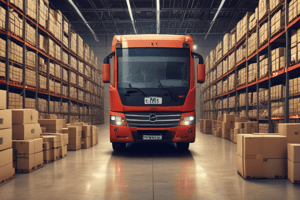Podcast
Questions and Answers
What is the main goal of logistics?
What is the main goal of logistics?
- To negotiate with suppliers to get the best prices
- To manage inventory levels and optimize warehouse space
- To maximize profits by reducing transportation costs
- To plan, coordinate, and execute the movement and storage of goods, products, and resources (correct)
What is the primary focus of outbound logistics?
What is the primary focus of outbound logistics?
- Managing the return of products from customers to manufacturers
- Storing, transporting, and delivering finished goods to customers (correct)
- Receiving and storing raw materials and components
- Coordinating with suppliers to ensure timely delivery
What is the term for combining multiple transportation modes?
What is the term for combining multiple transportation modes?
- Intermodal logistics (correct)
- Hybrid logistics
- Multimodal logistics
- Integrative logistics
What is the primary goal of just-in-time (JIT) logistics?
What is the primary goal of just-in-time (JIT) logistics?
What is the term for the percentage of deliveries made on schedule?
What is the term for the percentage of deliveries made on schedule?
What is the primary function of transportation management systems (TMS)?
What is the primary function of transportation management systems (TMS)?
What is the term for the number of times inventory is sold and replaced within a period?
What is the term for the number of times inventory is sold and replaced within a period?
What is the term for managing the return of products from customers to manufacturers?
What is the term for managing the return of products from customers to manufacturers?
Flashcards are hidden until you start studying
Study Notes
Definition and Scope
- Logistics refers to the planning, coordination, and execution of the movement and storage of goods, products, and resources from one place to another.
- It involves the integration of information, transportation, inventory, warehousing, material handling, and packaging.
Key Activities
- Inbound logistics: receiving, storing, and distributing raw materials and components.
- Outbound logistics: storing, transporting, and delivering finished goods to customers.
- Reverse logistics: managing the return of products from customers to manufacturers.
Types of Logistics
- Land logistics: transportation by road, rail, and inland waterways.
- Air logistics: transportation by air.
- Sea logistics: transportation by ocean.
- Intermodal logistics: combining multiple transportation modes (e.g., truck, rail, ship).
Logistics Functions
- Transportation management: planning, coordinating, and executing the movement of goods.
- Inventory management: controlling and maintaining inventory levels.
- Warehouse management: managing storage, receiving, and shipping operations.
- Supply chain management: coordinating and integrating logistics activities with suppliers and customers.
Logistics Strategies
- Just-in-time (JIT) logistics: delivering products just in time to meet customer demand.
- Postponement strategy: delaying final product assembly until customer orders are received.
- Third-party logistics (3PL): outsourcing logistics activities to a third-party provider.
Logistics Performance Metrics
- Lead time: time from order receipt to delivery.
- Inventory turnover: number of times inventory is sold and replaced within a period.
- On-time delivery rate: percentage of deliveries made on schedule.
- Fill rate: percentage of customer orders fulfilled from existing inventory.
Technology in Logistics
- Transportation management systems (TMS): software for managing transportation operations.
- Warehouse management systems (WMS): software for managing warehouse operations.
- Radio-frequency identification (RFID): technology for tracking and identifying products.
- Blockchain: technology for secure and transparent supply chain management.
Definition and Scope
- Logistics involves planning, coordinating, and executing the movement and storage of goods, products, and resources from one place to another, integrating information, transportation, inventory, warehousing, material handling, and packaging.
Key Activities
- Inbound logistics involves receiving, storing, and distributing raw materials and components.
- Outbound logistics involves storing, transporting, and delivering finished goods to customers.
- Reverse logistics involves managing the return of products from customers to manufacturers.
Types of Logistics
- Land logistics involves transportation by road, rail, and inland waterways.
- Air logistics involves transportation by air.
- Sea logistics involves transportation by ocean.
- Intermodal logistics combines multiple transportation modes (e.g., truck, rail, ship).
Logistics Functions
- Transportation management involves planning, coordinating, and executing the movement of goods.
- Inventory management involves controlling and maintaining inventory levels.
- Warehouse management involves managing storage, receiving, and shipping operations.
- Supply chain management involves coordinating and integrating logistics activities with suppliers and customers.
Logistics Strategies
- Just-in-time (JIT) logistics involves delivering products just in time to meet customer demand.
- Postponement strategy involves delaying final product assembly until customer orders are received.
- Third-party logistics (3PL) involves outsourcing logistics activities to a third-party provider.
Logistics Performance Metrics
- Lead time is the time from order receipt to delivery.
- Inventory turnover is the number of times inventory is sold and replaced within a period.
- On-time delivery rate is the percentage of deliveries made on schedule.
- Fill rate is the percentage of customer orders fulfilled from existing inventory.
Technology in Logistics
- Transportation management systems (TMS) are software for managing transportation operations.
- Warehouse management systems (WMS) are software for managing warehouse operations.
- Radio-frequency identification (RFID) is technology for tracking and identifying products.
- Blockchain is technology for secure and transparent supply chain management.
Studying That Suits You
Use AI to generate personalized quizzes and flashcards to suit your learning preferences.




